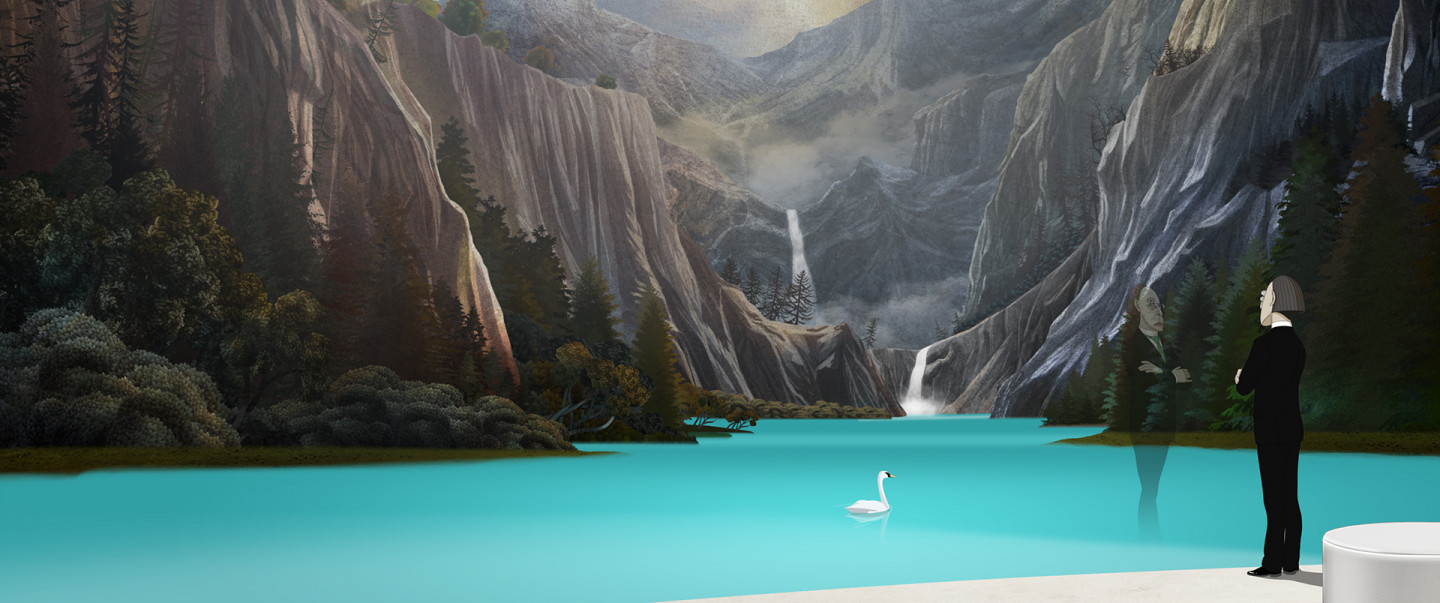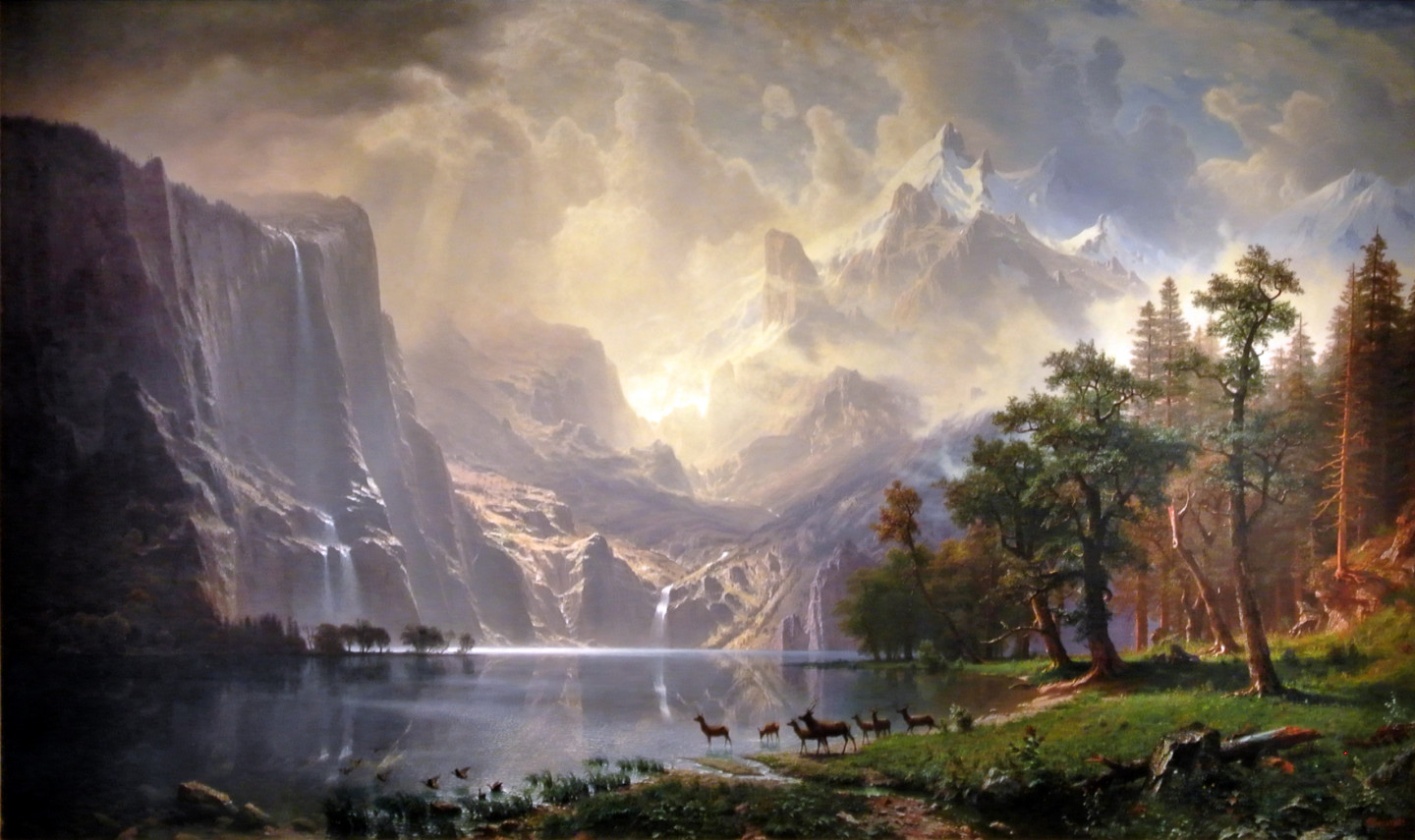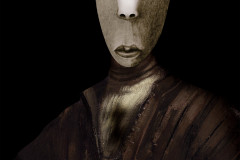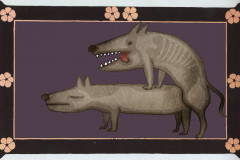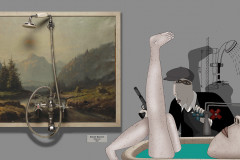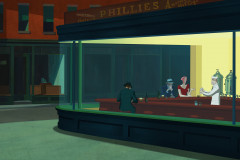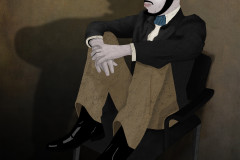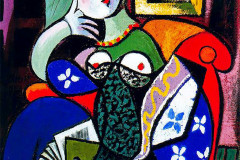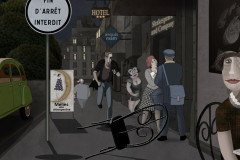Bierstadt, Albert (1830-1902): A Sierra Nevada hegyei között, 1868 (olaj, vászon, 185 x 308 cm) Smithsonian American Art Museum, Washington. A német bevándorlócsaládból származó Bierstadt a vadregényes amerikai tájat a művészet számára felfedező realista tájképfestők csoportjához tartozott. Ruben Brandt pszichiáterének hatalmas üvegfalú rendelőjéből tárul elénk a lélegzetelállító látvány.
A nemcsak művészi, hanem vállalkozói tehetséggel is megáldott Bierstadt 1863-ban író barátjával több ezer mérföldet utazva bejárta az amerikai vadnyugatot, s az ezalatt készített tanulmányrajzaiból aztán műtermi körülmények között festette meg hatalmas vásznait. A Sierra Nevada vízesésekkel, tavakkal tarkított hegyeit Rómában festette meg, s az amúgy is látványos tájat festői eszközeivel még fenségesebbé tette. Az előtér nyugalmas tópartjától fokozatosan halad tekintetünk egyre távolabb, az egyre drámaibban magasodó sziklák felé, melyek aztán V alakban nyílnak meg, hogy helyet adjanak a felhők mögül átszűrődő napfény által keltett gyönyörű fényjátéknak. A festői munka végeztével következett a marketing: Bierstadt képeinek bemutatására külön alkalmakat szervezett, amelyek hasonló társasági és művészeti események voltak, mint manapság egy színházi premier vagy egy várva várt film vörös szőnyeges bemutatója. A dekoratív keretbe foglalt vásznat nemes anyagú drapéria takarta, sötétített terembe léptek be a bemutatóra előre jegyet váltott vendégek, akik a képhez kitalált szöveges bevezető után tapsviharral köszöntötték a megfelelő pillanatban leleplezett vásznat. A Sierra Nevadát ábrázoló festményt Róma után Berlinben és Londonban is bemutatták, mielőtt az Egyesült Államokba hajózott volna, s ezzel nemcsak a festőnek, de az amerikai kivándorlásnak is egy kis reklámot csináltak.
Bierstadt, Albert (1830–1902): Among the Sierra Nevada Mountains, 1868 (oil on canvas, 185 x 308 cm, Smithsonian American Art Museum, Washington). A member of the group of realist landscape painters who “discovered” the untamed American wilderness for the world of art, Bierstadt—himself from a German immigrant family—created vast, awe-inspiring canvases that elevated nature to the level of the sublime. In Ruben Brandt, Collector, this breathtaking scene unfolds behind the glass wall of the psychiatrist’s office.
Endowed with both artistic vision and entrepreneurial skill, Bierstadt traveled thousands of miles through the American West in 1863 with a writer friend, gathering sketches and studies that he later transformed into monumental paintings in his studio. He painted Among the Sierra Nevada Mountains in Rome, where he amplified the landscape’s natural splendor through dramatic compositional choices. From the tranquil lakeshore in the foreground, the viewer’s gaze is gradually drawn upward and inward toward towering, craggy peaks that part in a sweeping “V” formation—revealing radiant sunlight streaming through the clouds in a masterful display of light.
Bierstadt’s process didn’t end with the brush. He orchestrated theatrical exhibitions of his paintings, turning them into major cultural events akin to today’s red-carpet film premieres. The finished canvas, framed ornately, would be veiled behind luxurious drapery. Guests with advance tickets entered a darkened room, where a carefully scripted introduction preceded the dramatic unveiling—often to applause. After its debut in Rome, the Sierra Nevada painting toured Berlin and London before being shipped to the United States, promoting not only the artist but, indirectly, the promise of westward expansion and American immigration.






